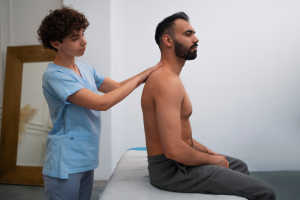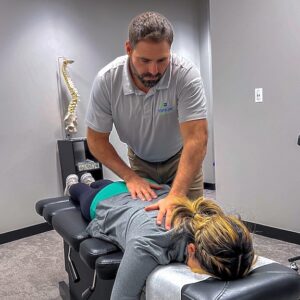What is nerve flossing? Also referred to as neural mobilization or a nerve gliding exercise, it involves gently moving a nerve back and forth within its sheath to reduce friction, break down adhesions and enhance its ability to glide freely with body movement. This form of nerve mobilization helps to mobilize and stretch specific nerves to reduce irritation and improve range of motion. It is done through a variety of specific exercises that increases both strength and flexibility.
Nerve flossing is important as it can help:
-
- Increase range of motion
-
- Reduce damage to nerves
-
- Improve strength and flexibility
-
- Relieve pain
-
- Release nerve tension
Nerve irritation often stems from compressed or inflamed tissue, repetitive strain or postural misalignment. For example, sciatic nerve flossing is commonly recommended for people experiencing radiating pain in the lower back, hips and legs. This type of flossing improves mobility while reducing nerve pain and inflammation.
Compared to static stretching or strength-focused physical therapy, nerve flossing focuses specifically on the movement of the nerve within surrounding structures. It’s not about muscle length – it’s about restoring the nerve’s freedom to move.
Several common conditions may benefit from nerve flossing exercises, including carpal tunnel syndrome, plantar fasciitis and muscle strains.
A nerve glide technique can also be helpful for people with thoracic outlet syndrome, piriformis syndrome and symptoms tied to repetitive use. Regular nerve flossing exercises may help decrease pain flare-ups and improve your body’s healing capacity when combined with chiropractic care.
An introduction to nerve flossing (from Woodstock chiropractor Dr. Allin)
Nerve Flossing Exercises
Nerve flossing techniques aim to move the nerve along its distribution by lengthening or shortening the path that the nerve must travel. Nerve flossing arm exercises target the median, ulnar and radial nerves through nerve tensioning and nerve gliding. When these nerves are irritated, they can produce symptoms like numbing, tingling and weakness down to the fingertips.
This repetitive movement encourages neural mobilization by breaking up adhesions and promoting blood flow to inflamed nerve tissue. A nerve flossing exercise can often alleviate tightness that muscle-focused stretches fail to address.
Two Types of Nerve Flossing Exercises
-
- Nerve Gliding
Nerve gliding exercises encourage the nerves to glide normally as you move your joints. Typically, this is done by pulling the nerve from one end and shortening it from the other end.
-
- Nerve Tensioning
Nerve tensioning entails tensioning one end of the nerve while simultaneously releasing tension on the other end. The repetitive motion aims to release adhesions that have developed along the nerve. Typically, this is done by stretching the nerve from both ends.
If you’re new to nerve flossing, it’s best to start with low-intensity nerve glides before progressing to tension-based work. This helps prevent flare-ups and allows the nervous system to adapt gradually. Sciatic nerve floss techniques have gained popularity among patients seeking conservative sciatica treatment that doesn’t rely solely on pain medication or injections.
The type of exercise that you need to perform will depend on the condition needed to be treated. For example, nerve flossing carpal tunnel exercises target the median nerve that passes through the neck. It is recommended to start with gliding exercises and slowly work towards tensioning exercises. These exercises are simple, do not require equipment and can easily be done at home.
When Should You Use Nerve Flossing?
If you’re dealing with chronic tingling, numbness, burning or shooting nerve pain, you might benefit from a targeted nerve flossing routine. These symptoms are often linked to limited nerve mobility caused by inflammation, injury or poor movement patterns.
Conditions like piriformis syndrome, sciatica or thoracic outlet syndrome are all candidates for neural mobilization. For example, a sciatic nerve floss can reduce compression along the lower back and buttocks, easing symptoms that travel down the leg.
That said, not everyone is a good candidate for a nerve flossing exercise. If you’re recovering from recent surgery, have signs of acute nerve damage or experience sudden weakness, it’s best to consult a professional. It’s also wise to avoid nerve flossing during active flare-ups unless specifically advised by a practitioner.
Chiropractic care may be an appropriate first step. A licensed chiropractor can assess your posture, muscular imbalances and spinal alignment to see if corrective care or neural gliding may help.
Median Nerve Flossing
The median nerve helps you move your forearm, wrist, hand and fingers. The nerve originates from the neck and passes through the front of the shoulder into the armpit and down into the hands.
Carpal tunnel syndrome is one of the most common conditions that affect the median nerve. Signs include numbness and tingling in the palm of the hand and the thumb, index or middle finger.
To determine if this exercise is for you, reach your palm out straight out away from you and press. If you feel symptoms (numbness/tingling in the palm of the hand and the first three fingers), that confirms that this exercise is in fact for you.
Steps for Median Nerve Gliding Stretches
-
- Stand up straight
- Place the arm to be stretched to the side of your body
- Press the arm forward with the palm facing upward
- Bring the palm towards your ear and look away
- As you look away it is good to side bend and drop the ear to the shoulder
- Hold the position for two seconds
- Repeat 10 times
The median nerve gliding exercises are stretching the nerve from the hand as we lessen the stretch from the neck and vice versa. It works by pulling the nerve in one direction and then pulling the nerve in the other direction.
It is normal to feel numbness or tingling while doing this exercise. If the symptoms persist 5-10 minutes after the exercise, then you might have pushed too hard or done too many repetitions. Make a note of this and next time reduce the number of repetitions, time hold and pressure.
Steps for Median Nerve Tensioning Stretches
-
- Stand up straight
- Place the arm to be stretched to the side of your body
- Press the arm forward with the palm facing upward
- Look away
- Hold the position for two seconds
- Repeat 10 times
This exercise is much more intense and you are going to feel it in the neck and into your fingertips. If you don’t feel anything, that means this exercise is not for you.
This exercise will start with approximately 10 repetitions working up to 30 repetitions. Every time you do this exercise, you can add three-five additional repetitions.
Flossing the Median Nerve
Ulnar Nerve Flossing
The ulnar nerve transmits electrical signals to muscles in the forearm and hand. The ulnar nerve is more commonly known as the funny bone. It starts up in the lower part of your neck, passes through the collarbone, goes under the peck bone through the armpit and wraps around the bone in the elbow down to the wrist.
If you experience numbness or tingling in your pinky finger and ring finger, then this is the right exercise for you.
Steps for Ulnar Nerve Gliding Stretches
-
- Stand up straight
- Put your index finger on top of your thumb to create tension in your pinky and ring finger
- Lift the heel of your hand upwards to your shoulder
- Lift elbow up
- Rotate head away
- As you come down, look down at the elbow
- Hold for 2 seconds and then release
- Repeat 10 times
Steps for Ulnar Nerve Tensioning Stretches
-
- Stand up straight
- Put your index finger on top of your thumb to create tension in your pinky and ring finger
- Lift the heel of your hand and your elbow upwards to just above your shoulder
- As the elbow comes up, rotate your head and tuck it away
- Hold for two to five seconds
- Come down
- Repeat 10 times
While you are doing these exercises it is normal to feel the symptoms increase. If you experience a lot of tingling or numbness, reduce the number of repetitions and hold and add more repetitions each time.
Nerve flossing for the Ulnar Nerve
Radial Nerve Flossing
The radial nerve travels from the lower part of the neck through the armpit down the back of the arm to the hand. It travels down the arm and supplies movement to the triceps muscle at the back of the upper arm.
If you have pain shooting down the back of your arm or experience numbness, then radial nerve flossing is for you.
Steps for Radial Nerve Gliding Stretches
For this exercise, we are going to stretch on one side and shorten on the other.
-
- Stand up straight with your arm down at your side
- Form a waiter’s tip hand where you take your hand and put your palm behind you
- Curl your fingers
- Look for your hand
- If you don’t feel a lot of stretch, bring your arm outward
- Bring the hand/arm forward
- As the hand comes forward and you bring it up toward your cheek, you are going to look away
- Hold the position for 2 seconds
- Repeat 10 times
To intensify this exercise, you can curl your fingers deeper and pull your arm out and away. It is normal to feel symptoms while doing this exercise but if they persist more than 5-10 minutes after completion, you may have aggravated the nerve by performing too many repetitions or applying too much intensity.
Steps for Radial Nerve Tensioning Stretches
-
- Stand up straight with your arm down at your side
- Form a waiter’s tip hand where you take your hand and put your palm behind you
- Curl your fingers
- Rotate the head away
- Tilt the head down
- Hold the position for 2 seconds
- Repeat 10 times
Flossing the Radial Nerve
What Should Nerve Flossing Feel Like?
It is normal to experience symptoms (i.e. numbness or tingling) while performing nerve flossing exercises. However, you should not feel pain when there is no stress or stretch on the nerve. The general rule of thumb is that five to ten minutes after the exercises are completed, symptoms should subside.
If you feel lasting pain or ongoing symptoms after the nerve flossing exercises, you may be doing too many repetitions or too aggressively. Making note of how you feel can help determine how many repetitions you should be doing when performing the exercise and at what intensity.
Some people notice immediate relief after a few repetitions, while others need consistent practice over several weeks. The key is pacing and being responsive to your body’s signals.
Do’s and Don’ts for Beginners:
- DO start slowly with gliding before progressing to tensioning
- DO listen to your body and back off if discomfort increases post-exercise
- DON’T push through sharp pain – this may aggravate inflammation
- DON’T perform nerve flossing multiple times per day without guidance
Click here to learn more about chiropractor Dr. Chris Allin at our Woodstock IL location.
Benefits of Working with a Chiropractor on Nerve Flossing
Partnering with a chiropractor can significantly improve your results with nerve flossing. A chiropractor can identify which nerves are restricted, why it’s happening and what techniques – like adjustments, massage therapy or targeted exercises – will provide the best results.
They also help make sure that you’re performing each nerve floss correctly to avoid irritation. This personalized approach is especially helpful for sciatic nerve issues or nerve entrapments in the upper limbs.
By combining chiropractic care with therapeutic movement, your care plan becomes more holistic and responsive. That means faster recovery, lower risk of re-injury and a clear roadmap toward corrective care.
A Simple Tool for Big Relief
Nerve flossing may seem simple, but it’s an incredibly effective method for relieving pressure, reducing symptoms and improving how your body moves. Whether you’re dealing with tingling fingers or radiating leg pain, it can be part of a comprehensive sciatica treatment plan.
If symptoms persist or worsen, don’t hesitate to consult a chiropractor to see how nerve flossing and hands-on therapies can be safely combined for your recovery. It might be the small tool that leads to major relief.




